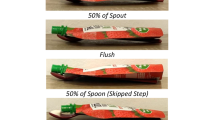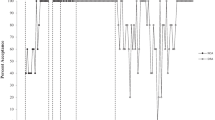Abstract
Escape extinction is an empirically supported treatment to increase food and drink acceptance in children with feeding difficulties. However, nonremoval of the spoon or cup may not be effective in isolation when children press their lips closed or clench their teeth. Physical guidance procedures may circumvent this concern, though this is not always the case and may require the bite or drink be deposited with an alternate utensil. Previous research has demonstrated the effectiveness of spoon-to-cup, syringe-to-cup, and syringe-to-spoon fading in typically developing children with gastrostomy tube dependence. The current study extends the existing research literature by replicating spoon-to-cup fading with a child with autism spectrum disorder who was an oral feeder, and by demonstrating the effectiveness of finger-to-spoon fading. We also provide an additional clinical example for syringe-to-cup fading for a child with autism spectrum disorder who was an oral feeder.


Similar content being viewed by others
References
Ahearn, W. H., Kerwin, M. E., Eicher, P. S., Shantz, J., & Swearingin, W. (1996). An alternating treatments comparison of two intensive interventions for food refusal. Journal of Applied Behavior Analysis, 29(3), 321–332. https://doi.org/10.1901/jaba.1996.29-321
Bachmeyer, M. H., Gulotta, C. S., & Piazza, C. C. (2013). Liquid to baby food fading in the treatment of food refusal. Behavioral Interventions, 28(4), 281–298. https://doi.org/10.1002/bin.1367
Benjasuwantep, B., Chaithirayanon, S., & Eiamudomkan, M. (2013). Feeding problems in healthy young children: Prevalence, related factors and feeding practices. Pediatric Reports, 5(2), 38–42. https://doi.org/10.4081/pr.2013.e10
Bertrand, V., Tiburce, L., Sabatier, T., Dufour, D., Déchelotte, P., & Tavolacci, M. (2021). Estimated prevalence and care pathway of feeding and eating disorders in a French pediatric population. Nutrients, 13(6), 2048. https://doi.org/10.3390/nu13062048
Borrero, C. S. W., Schlereth, G. J., Rubio, E. K., & Taylor, T. (2013). A comparison of two physical guidance procedures in the treatment of pediatric food refusal. Behavioral Interventions, 28(4), 261–280. https://doi.org/10.1002/bin.1373
Cho, S., & Sonoyama, S. (2020). Combining stimulus fading with simultaneous presentation in a school setting for food selectivity in a child with autism spectrum disorder. Education & Treatment of Children, 43, 335–345. https://doi.org/10.1007/s43494-020-00011-5
Field, D., Garland, M., & Williams, K. (2003). Correlates of specific childhood feeding problems. Journal of Pediatric & Child Health, 39(4), 299–304. https://doi.org/10.1046/j.1440-1754.2003.00151.x
Fisher, W., Piazza, C. C., Bowman, L. G., Hagopian, L. P., Owens, J. C., & Slevin, I. (1992). A comparison of two approaches for identifying reinforcers for persons with severe and profound disabilities. Journal of Applied Behavior Analysis, 25, 491–498. https://doi.org/10.1901/jaba.1992.25-491
Groff, R. A., Piazza, C. C., Volkert, V. M., & Jostad, C. M. (2014). Syringe fading as treatment for feeding refusal. Journal of Applied Behavior Analysis, 47, 834–839. https://doi.org/10.1002/jaba.162
Groff, R. A., Piazza, C. C., Zeleny, J. R., & Dempsey, J. R. (2011). Spoon-to-cup fading as treatment for cup drinking in a child with intestinal failure. Journal of Applied Behavior Analysis, 44, 949–954. https://doi.org/10.1901/jaba.2011.44-949
Koomar, T., Thomas, T. R., Pottschmidt, N. R., Lutter, M., & Michaelson, J. J. (2021). Estimating the prevalence and genetic risk mechanisms of ARFID in a large autism cohort. Frontiers in Psychiatry, 12, 1–14. https://doi.org/10.3389/fpsyt.2021.668297
Kovacic, K., Rein, L. E., Szabo, A., Kommareddy, S., Bhagavatula, P., & Goday, P. S. (2021). Pediatric feeding disorder: A nationwide prevalence study. Journal of Pediatrics, 228, 126-131.e3. https://doi.org/10.1016/j.jpeds.2020.07.047
Luiselli, J. K., Ricciardi, J. N., & Gilligan, K. (2005). Liquid fading to establish milk consumption by a child with autism. Behavioral Interventions, 20(2), 155–163. https://doi.org/10.1002/bin.187
Piazza, C. C., Fisher, W. W., Brown, K. A., Shore, B. A., Patel, M. R., Katz, R. M., Sevin, B. M., Gulotta, C. S., & Blakely-Smith, A. (2003). Functional analysis of inappropriate mealtime behaviors. Journal of Applied Behavior Analysis, 36(2), 187–204. https://doi.org/10.1901/jaba.2003.36-187
Rubio, E. K., Borrero, C. S. W., & Taylor, T. (2015). Use of a side deposit to increase consumption in children with food refusal. Behavioral Interventions, 30, 231–246. 10.1002.bin.1404
Rubio, E. K., McMahon, M. X. H., & Volkert, V. M. (2021). A systematic review of physical guidance procedures as an open-mouth prompt to increase acceptance for children with pediatric feeding disorders. Journal of Applied Behavior Analysis, 54(1), 144–167. https://doi.org/10.1002/jaba.782
Rubio, E. K., Volkert, V. M., Farling, H., & Sharp, W. G. (2020). Evaluation of a finger prompt variation in the treatment of pediatric feeding disorders. Journal of Applied Behavior Analysis, 53(2), 956–972. https://doi.org/10.1002/jaba.658
Sharp, W. G., Jaquess, D. L., Morton, J. F., & Miles, A. G. (2011). A retrospective chart review of dietary diversity and feeding behavior of children with autism spectrum disorder before and after admission to a day-treatment program. Focus on Autism & Other Developmental Disabilities, 26(1), 37–48. https://doi.org/10.1177/1088357609349245
Taylor, T. (2020). Side deposit with regular texture food for clinical cases in-home. Journal of Pediatric Psychology, 45(4), 399–410. https://doi.org/10.1093/jpepsy/jsaa004
Volkert, V. M., & Piazza C. C. (2012). Pediatric feeding disorders. In M. Herson & P. Sturmey (Eds.), Handbook of evidence-based practice in clinical psychology, Volume 1: Child and adolescent disorders. Wiley.
Author information
Authors and Affiliations
Corresponding author
Ethics declarations
Data Availability
All data generated or analyzed during this study are included in this published article.
Ethics Approval
This research study was conducted retrospectively from data obtained for clinical purposes. Per the IRB policies of Kennedy Krieger Institute and Johns Hopkins University School of Medicine, ethical approval was not required.
Conflict of Interest
None of the authors have any conflicts of interest to report.
Consent to Participate
Informed consent for clinical treatment was obtained from participants’ legal guardians.
Additional information
Publisher's Note
Springer Nature remains neutral with regard to jurisdictional claims in published maps and institutional affiliations.
We conducted this research at Kennedy Krieger Institute in Baltimore, MD. Racheal Clark is now affiliated with Brighter Hope Wellness Center in Clarksville, Maryland; Kathryn Chumney is now affiliated with Arundel Lodge Behavioral Health in Annapolis, MD; and Taylor Birmingham is now affiliated with UnitedHealthcare in Columbia, MD.
Electronic supplementary material
Below is the link to the electronic supplementary material.
Appendices
Appendix A
Description and pictorial depiction of finger-to-spoon fading procedures for Darius
Step | Description |
|---|---|
1 | Finger feed: Therapist placed the bite with their fingers to Darius’s lips without a spoon present |
2 | Food in front: Therapist placed and held the bite so that the bite was in front of and touching the tip of the spoon |
3 | Half-spoon: Therapist placed and held the bite so that the back half of the bite was on the front of the spoon |
4 | Three-quarter spoon: Therapist placed and held the bite so that the back three-quarters of the bite was on the front of the spoon |

Appendix B
Description and pictorial depiction of spoon-to-cup fading steps for Sebastian
Step | Description |
|---|---|
1 | Base of spoon flush with lip of the cup |
2 | Lip of the cup positioned ¼ of the way up from the base of the spoon |
3 | Lip of the cup positioned ½ of the way up from the base of the spoon |
4 | Lip of the cup positioned ¾ of the way up from the base of the spoon |
5 | Lip of the cup flush with the tip of the spoon |

Rights and permissions
Springer Nature or its licensor (e.g. a society or other partner) holds exclusive rights to this article under a publishing agreement with the author(s) or other rightsholder(s); author self-archiving of the accepted manuscript version of this article is solely governed by the terms of such publishing agreement and applicable law.
About this article
Cite this article
Kozlowski, A.M., Clark, R., Workman, B. et al. Utensil Fading to Increase Appropriate Utensil Acceptance. Behav Analysis Practice (2024). https://doi.org/10.1007/s40617-024-00911-7
Accepted:
Published:
DOI: https://doi.org/10.1007/s40617-024-00911-7




